Monetización móvil 101: los primeros pasos
“Deberíamos haber pensado en la monetización desde el principio”
Se han lanzado innumerables juegos gratuitos y han fracasado, y este es un lamento constante que muchos equipos de juegos tienen. Deberían haber hecho más al principio para pensar en la monetización. Deberían haber pensado mucho más en cómo su juego iba a generar dinero en lugar de simplemente hacer un buen juego.
Aprender a evaluar la monetización desde el principio es difícil. La mayoría de los recursos hablan sobre mecánicas inteligentes de monetización (por ejemplo, precios de compras dentro de la aplicación, ofertas por tiempo limitado, sistemas VIP, ventas, etc.), pero rara vez hay mucha información sobre cómo saber si su primer prototipo tiene lo necesario para eventualmente monetizar. La observación común sobre la monetización es que una buena monetización solo puede provenir de una buena retención, como si simplemente hacer un juego divertido hiciera inherentemente que tu juego se monetizara. Cualquiera que haya lanzado un juego gratuito sabe que esto no es del todo correcto.
La verdad es que la monetización y la retención están fuertemente interconectadas y debes pensar en ambas lo antes posible dentro de tu juego. La monetización no es algo con lo que puedas tropezar si quieres competir en la AppStore.
Pero antes de empezar a obsesionarte con los precios de compra dentro de la aplicación y antes de empezar a obsesionarte con las mecánicas de monetización furtivas, debes descubrir cómo va a sobrevivir tu juego como juego gratuito. La mejor manera de configurar la monetización en tu juego es asegurarte de que tu juego tenga 3 cosas:
- Una definición clara de lo que vende principalmente.
- Garantías de que sus sistemas durarán años
- Formas de llevar al jugador al final del juego.
Completar estos 3 pasos te permitirá configurar tu juego para monetizarlo en todo su potencial.
Paso 1: ¿Qué estás vendiendo?
Cada juego gratuito con mayores ganancias vende principalmente los medios para progresar .
El progreso es el motor más fuerte de la monetización . Los juegos que más recaudan no venden contenido (por ejemplo, DLC), sino que venden progreso hacia el final del juego.
El progreso se presenta en muchas formas y tamaños. Podría significar avanzar en un mapa. El progreso podría significar construir una granja. El progreso podría significar recolectar y mejorar personajes. Para empezar, debes definir qué significa el progreso para tu juego.
Echemos un vistazo a 2 juegos y lo que significa el progreso para ellos:
Candy Crush

El progreso principal de Candy Crush es avanzar en un mapa . Candy Crush centra todas sus mecánicas de monetización en ayudar a progresar en el mapa. Venden potenciadores, movimientos adicionales o amuletos que te ayudarán a progresar.
Galaxia de los Héroes de Star Wars
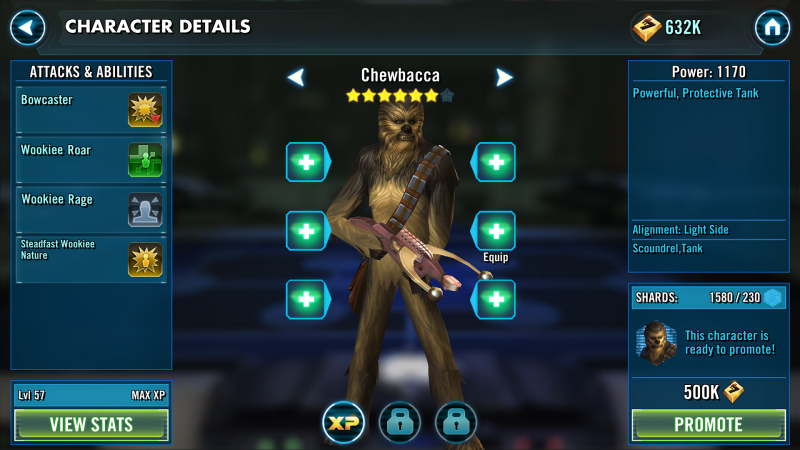
Galaxy of heroes is all about upgrading collecting heroes. Each game mode promotes the need to have a large collection of characters. As the game progresses, it demands an increasing upgrade level of your characters, requiring you to progress. They sell the means to progress faster: currencies to train your characters, the ability to fight battles instantaneously, and loot cards to unlock characters faster than your normally can.
Every top grossing game has a long path of progress which is the main focus of their monetization.
You must define the core progress for your game. What do you see players building over a long period of time?
Just to give more examples, here are some of the Top Grossing games’ Core Progress:
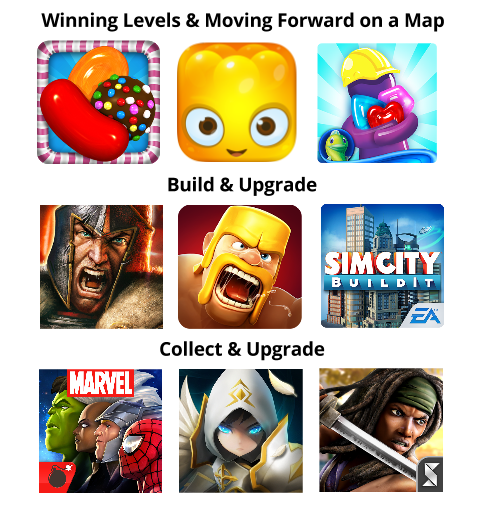
For each of these games, this core progress is the central focus of their monetization strategy. All monetization mechanics give options for the players to speed up their progress.
When you’ve discovered what your core progress is — what the key central point you are going to be selling — then you can start designing monetization mechanics that speed up the player’s progress in interesting ways. You can start designing mechanics that pace the player’s progress giving you opportunities to monetize.
But there is one important step you need to do before you can start creating monetization mechanics: you need to ensure this core progress will actually last. Otherwise you won’t be selling progress for very long.
Step 2: How long will it last?
What you are selling must be able to scale for years.
It doesn’t matter how many monetization tricks you’ve got in your game. If what you’re selling won’t last, you won’t be successful.
This is usually where systems begin to show weakness. Not many systems can last for years. Many of the games that we all loved growing up were great games, but only lasted 10 or 20 hours before the system would crack. These games aren’t well suited for free to play.
An example of this happened when I was working on a racing game prototype. The core of the game was to race against an opponent to the finish while avoiding obstacles.
Our core progress was upgrading your car (similar to CSR Racing). The player collected loot from races to purchase upgrades which would improve their car’s stats. To progress in the game, the player needed higher and higher stats. The key stats to progress were: Speed, Handling, Acceleration and Boost/Nitro. As we tested out the game, we noticed: the more you improved the Speed stat, the harder the game became. The player’s cars were moving faster, which meant that the obstacles were becoming harder to avoid. We had a very limited cap that the speed could be upgraded to without demanding way too much skill from players.
With this cap in mind, we tried many things to avoid the issue. We made all obstacles travel with the player based on the player’s speed to make high speeds more manageable (instead of stationary obstacles, we switched to cars driving with the player on a highway). We adjusted the opposing AI’s speed based on your upgrade level to ensure that each upgrade was necessary. We tried many weird tricks to get the system to work, but all of them fell apart and were making the gameplay feel confusing.
In the end, the cap on our speed stat wasn’t high enough. In order for the game to be successful we needed the cars from the beginning of the game to be much, much slower than the cars at the end of the game. If we wanted the end of the game to take a months to reach, yet each upgrade along the way to feel meaningful to progress, the “Speed” stat was just not going to work.
This was a signal that our system wasn’t going to scale, and our game was not going to work as free to play.
Compare this Speed stat problem to a regular RPG system with Health and Attack. This system can scale almost infinitely. A 200 HP monster when you have 20 attack is the same as a 200,000 HP monster when you have 20,000 attack. Attack and Health counter each other, allowing both to grow infinitely large. Speed had no counter stat, which made its growth eventually constrained. This is why many free to play games rely on an RPG system of Health vs Attack (ex. Clash Royale, Clash of Clans, Best Fiends, Puzzles and Dragons, Summoner’s War) this simple system can scale.
Look at your base gameplay — do the stats scale?
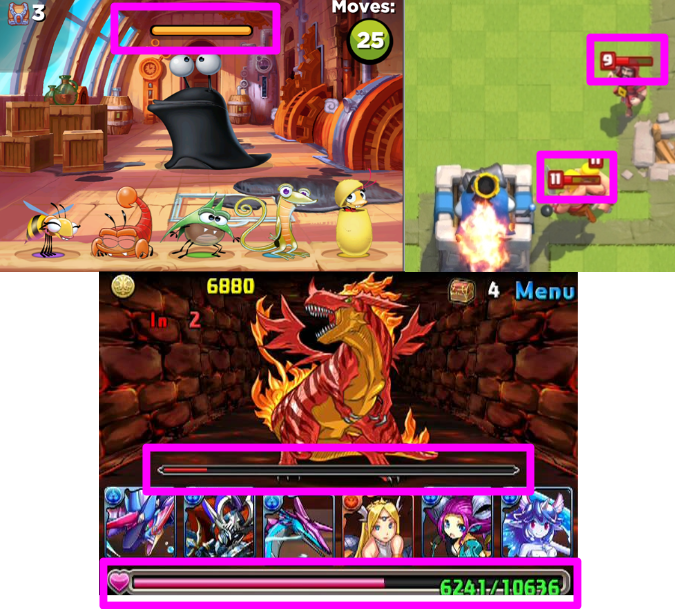
Health vs Attack: The infinitely scalable system that many of the top free to play games use.
So how do you apply this to an early prototype? How do you ensure that your system will last?
2 basic tools you can use to evaluate your scalability:
- Model your economy
- Test your game in the Beginning, Mid and Endgame
Model your Progression
Modelling your game’s economy and progress early is an easy way to give you a sense of just how much content you need and how to pace your game.
Exactly how to do this is a very deep topic that I’d love to cover some day. If you don’t have the skillset on your team to model your economy with a tool like Excel, then you need to get someone who can. Without modelling, it is impossible to see just how you’re going to get your game to last.
But what should the goal be? How long should your game’s progress last?
10,000 hours or $10,000 dollars: that’s how long your system should last.
This of course is just a high level estimate (and easy to remember) but this is a good goal to have if your looking to reach the top grossing charts. Looking at the top games today, they easily go beyond these numbers. Games like Clash of Clans support purchases larger than $10,000 in their games. In comparison to Game Of War, this economy can support a purchases by a single user of over $120,000. These are insane values, but to give you a sense of just how long lasting and resilient these economies are. There is a lot of room in these economies to monetize.
With this model, you have a great tool to show what it will take to last. Compare your model against the models of your competitors in your genre and you’ll have even greater benchmarks for how much content you will need. If you want to beat the competition, your game has to last longer.
Test your Beginning Game, Mid Game, and End Game
When you’ve modelled your game’s economy, you will have a sense of what the beginning game, mid game and end game’s content will be. From this, you can build a prototype which can showcase how the game will feel in the beginning, in the middle and in the end. With this prototype you can ask questions like:
In the beginning, do player progress quickly?
Is each progress step desirable and felt as required by the player?
Is this beginning of the game still engaging or have you taken away too much of the depth?
Is the gameplay easy to get into?
In the midgame, has it sufficiently changed from the beginning game? Does it feel like the game is getting deeper?
In the end game, does the game still work?
Is the amount of skill required to succeed still feel achievable to all of your player types?
Is the end game sufficiently complex and deep? How does my end game depth compare to my competitors?
Is there a dominant strategy, or do you see your end game players debating over best choices?
There are many more questions to ask to ensure the depth of gameplay is there at each stage, but these 3 prototypes can give you a better sense that progress is happening and that your game will work at these 3 stages. This will ensure that the progress that you will be selling is desirable, and that the end game is worth reaching.
Using a model and effectively testing your game at multiple stages in the game is the basics of how to prove your game can last. When your game can last, then you now have the necessary base of a game that can monetize. Now it is time to start driving desire to spend.
Step 3: Why do I care?
You’ve got a core system that can last for years, and a clear definition of what you are selling. All that doesn’t matter if players have no desire to progress.
As free to play games, we are selling virtual items. In reality these things have no value. Our job as game designers is to create systems which create value for our virtual items. When our virtual items have value, we are much more likely to monetize.
Making virtual items valuable is not easy, but thus far most free to play games have focused on 2 ways to do this:
- Visual progress teasing a long term vision of the end game
- Social Pressure
Visual Progress Tease Long Term Vision
The majority of free to play games use visual progress cues to create a sense of value as you progress through the game. Visual progress can come in many forms, but it must showcase your progress thus far as well as tease future progress. Showcasing your previous progress gives value to your work so far. Gives you real value for your playing time or payments in the past. Teasing the future content gives the “carrot on the stick”. Shows players that there is lots more to come, and hopefully entices them to discover the new content still awaiting them.
The 3 most used examples of visual progress are:
- The Saga Map
- Base Expansion
- Character Collection
#1 The Saga Map
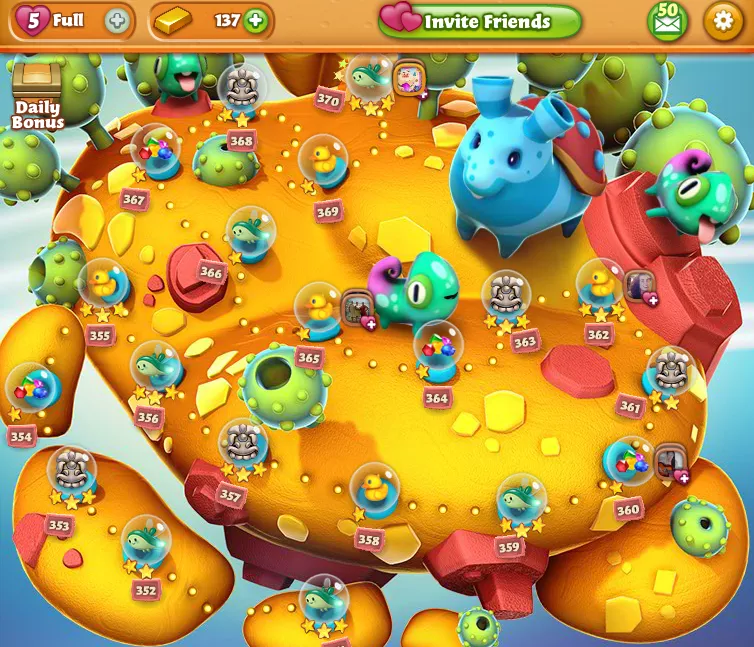
The Saga map in puzzle games clearly shows the visual progress of the player. Each time you complete a level, you progress on the map. At any time in the future you can scroll through the map and feel good about the progress you’ve made.
At the same time it clouds over the future worlds and hints at the mountain of content yet to come, giving you a reason to continue playing to discover the content.
#2 Base Expansion Building Progress in Clash of Clans
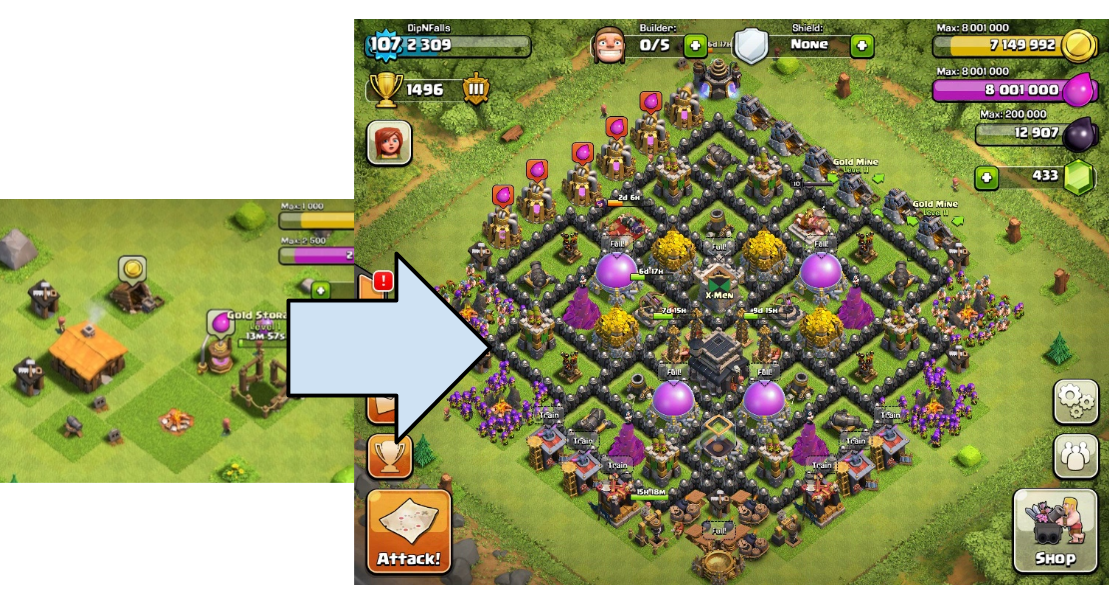
Clash of Clans and almost every game like it with a city/base-building component has this to create greater visual progress to the user. Looking at an early level base in Clash of Clans to a late base really shows just how far a player has come. Each time they enter the game they are reminded of their progress. Each base also feels completely customizable and your own. You decide where each piece of wall goes. This creates more attachment to the visual progress — this is your own base.
On top of this, players are teased each time they preview a greater opponent. They can look at the top of the leaderboards and be tempted by how amazing the bases look near the end game.
#3 Characters in Star Wars Galaxy of Heroes
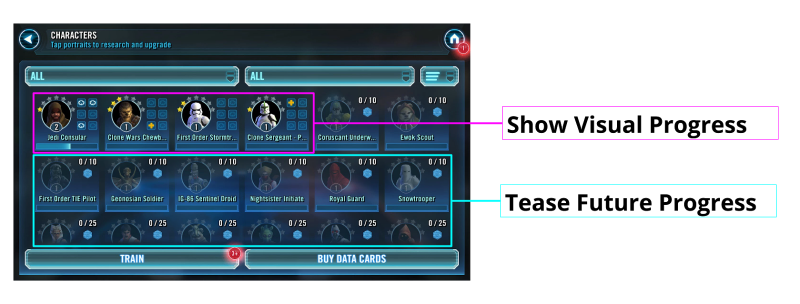
Looking at your character list in Galaxy of Heroes is the best way to see your progress and be teased of the future content.
You can see each of your characters and how amazing they are. This showcases their value. Just below your characters, you can see transparent versions of the characters you have yet to unlock, enticing you of the future progress pulling you along.
These 3 examples show how the top grossing games use visual progress to create value and desire. Each are also tightly tied to what the core progress is for the game itself.
When your core progress is visual, players are much more likely to feel like it is valuable and worth playing or paying for. When progress is teased, players are much more likely to stick around to see what happens.
Social Pressure

Want your game to monetize? Then make sure players are engaged socially within your game!
Deep Social mechanics is the key to building a game that retains the longest and monetizes the strongest. When a player is actively engaged in a lively community of players, then the content in the game is far more valuable. As a player, I am far more likely to spend . We’ve already written a lot about how strong community features in your game will heavily influence how well you can monetize:
- Dawn of the Dragons (5th Planet Games): conversion rate for non guild members: 3.2% vs. guild members: 23%
- Tyrant Unleashed (Synapse Games): ARPU for non guild members: $36.59, vs. guild members: $91.60
It is not a coincidence that MMOs like Habbo Hotel (pictured above) monetize so strongly with a core interactions that are quite simple. The deep social interactions that are possible in Habbo Hotel pull players in over a long period of time. Because of this strong social connection, players put a much higher value on looking good, showing off their progress and helping others. As a result players play longer and pay more money.
So when you’re thinking about monetization, make sure that you have truly defined what is going to be pulling players through the game on the long haul. Ensure you have strong visual progress mechanics that show off the player’s progress and tease the late game. Ensure that you have social mechanics which give real value to the content that you’re creating. If players have minimal desire to progress, then it doesn’t matter what monetization tricks you have — they won’t play long enough to spend.
The Last Step: Capitalize
You can see that Steps 1, 2 and 3 don’t really talk directly about monetization. There’s not much about skipping timers, VIP programs, limited time offers or designing virtual currencies. It’s because all that doesn’t matter unless you’ve got a long lasting game.
This is really why many monetization topics usually say “think about Retention before you think about Monetization”. What the real crux of it this statement is: don’t think about monetization unless you’ve got a system that can last. Obsessing over monetization mechanics before you’ve got a long lasting system is futile. However if you’ve nailed a long lasting system that can keep players engaged for a long time, the remaining steps to monetize become significantly easier.
Cuando tienes un sistema duradero, puedes comenzar a crear mecánicas que hagan avanzar más rápido al jugador en esa progresión pagando o jugando de la manera que quieras. Con suficiente deseo de llegar al final del juego, puedes obligar a los jugadores a gastar repetidamente para llegar a él. Aquí es donde comienza la verdadera monetización.
¡Próximamente más información sobre las formas de capitalizar sus sistemas de monetización duraderos!
Otras lecturas:
Éxito del núcleo medio: monetización, Michail Katkoff:
http://www.deconstructoroffun.com/2013/11/mid-core-success-part-4-monetization.html?q=monetization
Dimitar Dragonov, Juegos móviles Freemium
https://www.amazon.com/Freemium-Mobile-Games-Design-Monetization/dp/1512322172
Conceptos críticos de monetización móvil, Joseph Kim
http:// quarterview.com/?p=774
La Torre de la Miseria, Ethan Levy
https://www.youtube.com/watch?v=tBG2G-9vl-M
Leave a Reply